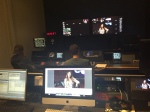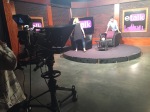Last fall, senior Devin Mehra began using the dating app Tinder, but was frustrated by the messaging feature — the back-and-forth mental games that led nowhere. So he created his own dating app, When & Where, now available on Elon University’s campus.
“Let’s say the guy takes six hours to get back to you. Does that mean you wait six hours, when clearly you just read the message and he probably just read the message too?” Mehra said. “I was thinking to myself there has to be a better solution to this than sitting around desperately by your phone, ‘Has this person texted me back yet?’”
Unlike other dating apps such as Tinder, Bumble and Hinge, When & Where gets straight to the point. If users see someone they’re interested in, they pick a time or place to go out. The two users agree when and where to meet before they can message in the app, but users don’t necessarily have to follow through with the meetup after messaging.
“I like to think of it as an icebreaker,” Mehra said. “Let’s say you don’t actually meet up at the time and place you agreed upon, but we keep talking and the idea comes up. By initially agreeing on the time and place when you first talk, I think it’s more natural to talk about meeting up.”
Users connect to the app through Facebook, allowing them to set a profile picture, write a description and choose up to five tags, such as “Rec League All Star,” “Chocolate Lover” or “Spunky” to describe themselves. Preferences can be set for age range and gender.

Every 24 hours, a user is given five different matches who are on campus rather than showing everyone available within the user’s preferences. Mehra believes this will cause users to think harder about who they choose to chat with.
“I think the problem with apps like Tinder is when you’re given that many options, the profiles almost become objects, and you don’t really think of them as people,” he said. “With this app you have to think about it harder. You have to think about them more as people than as faces on the screen.”
With about 350 users on Elon’s campus, there are a finite number of matches to go through, so eventually old matches will reappear.
Mehra had the idea for the app back in November 2014, but with no knowledge of programming, he needed some help. Luckily, his family friend Daniel Shaffer was willing to code for him. In January, Shaffer had Mehra physically draw out every screen of the app.
“I felt that he was very, very passionate about it,” Shaffer said. “He thought everything through, which was really nice.”
In March Shaffer began coding, and launched the app in July.

According to Shaffer, programming the app was a bit difficult because he needed to create a system that tracks all the whens, wheres and matches, as well as that he incorporates geographic data and the ability to connect to Facebook.
Since the app is still in its infancy stage, there are a few bugs that need to be fixed, such as buttons overlapping on the screen. Mehra plans to fix this through updates and hopes to add push notifications to remind people to open it.
“It’s one thing to have people downloading the app, it’s another thing to have people looking at it and opening it,” he said.
Right now, Shaffer recommends promoting the app over any big developments.
“Innovators’ dilemma is not knowing when enough is enough,” Shaffer said. “The app is at a point where it’s good enough to do marketing. It’s his baby right now. I’ve told him the app’s great right now, and his time should be spent getting the word out.”
At Elon, Mehra has been promoting When & Where through word of mouth and presenting at different organizations, such as fraternities, sororities and clubs. He is also incorporating social media by posting about the app and sharing an interview on Facebook.
Currently the app is only available at Elon because to develop and market social apps, marketers need to start in concentrated areas, so users aren’t scattered where they can’t reach each other.
So far, Mehra has heard a few success stories from users.
“There are people I have spoken to, who I don’t really know, that have met up with someone they never met before and met up at [The] Oak House,” he said. “It’s a really cool thing to have people you don’t know actually using the app and using it the way you visualized.”
After marketing on campus, Mehra hopes to expand to nearby campuses or to Boston, where his brothers go to school.
He also wants users to get more creative with the wheres in the app by choosing unique locations or meeting up with their friends to hang out through it.
“You can pick the most obscure locations, you can do [The] Oak House but you can also do Lakeside Dining Hall or Phoenix Card Office,” Mehra said. “Yes, it’s a dating app, but I want people to have fun with it and not take it so seriously.”











